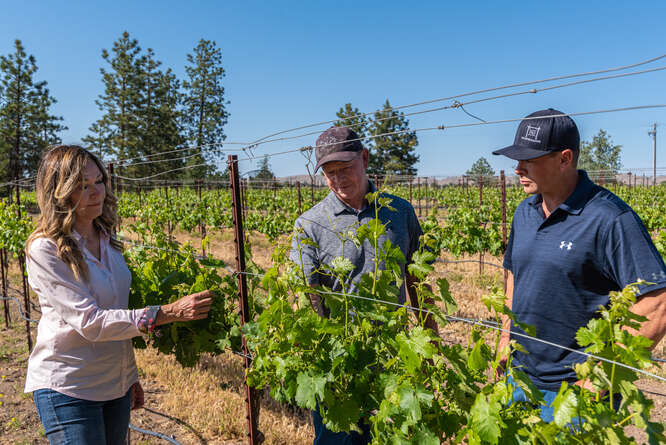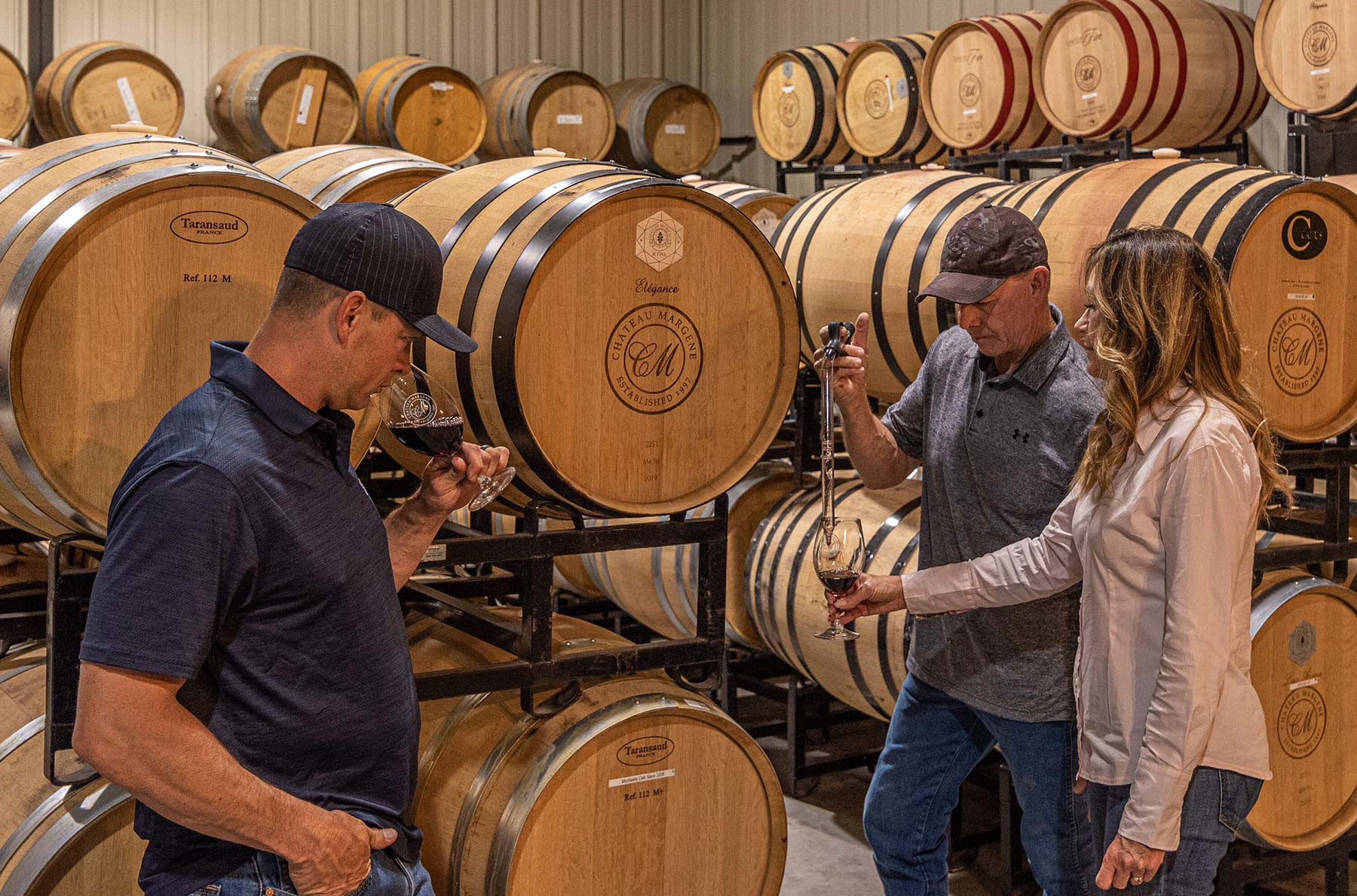Story

Chateau Margene, now in its 27th year, began with the fulfillment of a dream by Michael & Margene Mooney to plant a vineyard, build a winery and establish their home in the Paso Robles area in 1997. The family took up residence on the property in the Summer of 1998 (where they still live today) and planted the estate vineyard in the Fall of 1998. Annual production varies between 2,500 – 3,000 cases annually, depending on Mother Nature and crop loads each vintage. The mantra is "quality over quantity". The two vineyard blocks on the estate are Stella’s Vineyard (named after Margene's Mother and their grand-daughter - Jon's daughter), planted in 2014 to two clones of Cabernet Sauvignon & Cabernet Franc. The front vineyard, Michael's Vineyard, is named after Michael & Margene's older son and their grandson. Varietals planted are Cabernet Sauvignon, Cabernet Franc, Merlot, Malbec & Sangiovese. The farming practices are organic and sustainable with Michael managing the vineyard and overseeing the winemaking with son Jon. Margene runs the day to day business and is the winemaker for their Cabernet Franc. The wines are primarily sold DTC (direct-to-consumer) and are available at their two tasting rooms or as a wine club member.
The Mooney Family label was started in 2004 with purchased grapes from growers in the Santa Lucia Highlands (SLH) and Sta. Rita Hills AVA's. The varietal focus for Mooney Family wines is Pinot Noir & Chardonnay from the SLH & SRH AVA's.
The ROXO Port Cellars label offers both Ruby and Tawny port-style wines. The Ruby wines are now aged a minimum of 7 years in French oak and the 2008 15 Year Tawny was aged for over 15 years in French oak. These wines are made Methodo Portuguese, which uses neutral grape spirits rather than Brandy to fortify the wine. The results speak for themselves.
El Pistolero - Michael’s family history in California dates back seven generations with his great, great grandfather being deeded a Mexican Land Grant in 1842 -Rancho Canada de Los Osos in San Luis Obispo County. The grant extended from the Pacific coast along Los Osos Valley toward present day San Luis Obispo and encompassed part of Montana de Oro State Park. The wines crafted under this label include a Chardonnnay, a Pinot Noir and a Bordeaux-style blend called "Riata Red" which are offered at their Morro Bay tasting room.
SOMM Journal article - OCTOBER 2023
The Pioneers of Paso
A LOOK AT THE COMMUNITY BEHIND THE CABERNET
by Marci Symington
California has a rich winemaking history dating to the 1700s, when Spanish missionaries established 21 missions stretching from San Diego to Sonoma along the historic El Camino Real and planted grapevines to produce sacramental wine. In the late 19th century, Paso Robles—with its Mediterranean climate, calcareous soils, and high diurnal temperature swings—became a major draw for commercial winemakers, many of European ancestry. In the decades to follow, Zinfandel and Rhône varieties such as Grenache, Syrah, and Mourvèdre would prove to be their calling cards.
However, in the 1970s and 1980s, winemakers like Gary Eberle, Justin Baldwin, and Michael Mooney came to the Central Coast region to plant Cabernet Sauvignon and other Bordeaux varieties. These pioneers overcame many hurdles—not the least of which was to educate the public on Paso’s location (no, it’s not to be confused with the West Texas town of El Paso)—to show the world that California’s so-called “Rhône Zone” could also produce world-class Bordeaux blends.
Along the way, they influenced a host of talented individuals who also recognized the area's potential, paving the way for Cabernet dominance. Enter brothers Daniel and Georges Daou, who, after achieving tremendous success in the tech industry, turned their eyes to Paso to realize their lifelong dream of establishing a winery. In 2013, Daniel convinced seven producers to start the Paso Robles CAB (Cabernet and Bordeaux) Collective (PRCC). Joining DAOU Family Estates were J. Lohr Vineyards & Wines, JUSTIN Vineyards & Winery, Adelaida Vineyards & Winery, Eberle Winery, Vina Robles Vineyards & Winery, and Chateau Margene. A grassroots organization whose aim is to raise awareness for the region’s Bordeaux varieties and to set the standards for its winemaking, the PRCC now has over 25 members—including a new generation of like-minded producers such as Benom Wines, Copia Vineyards, and Glunz Family Winery, which are helping to raise the bar on quality, innovation, and customer experience. Here, we get acquainted with a few of them.
Justin Baldwin, JUSTIN Vineyards & Winery
“I like doing things that others haven’t done,” says Justin Baldwin, founder of JUSTIN Vineyards & Winery. “I was drawn to that pioneering aspect of being one of the early founders and early participants in the Paso wine industry. Nobody, including me, would have guessed it would have enjoyed [such] incredible success.”
As an investment banker, Baldwin lived and traveled worldwide before settling in Los Angeles. For his second act, he dreamed of crafting premium Bordeaux wines along the Central Coast of California. “When I started, I had no intention of violating my number-one rule of winemaking, ‘Don’t quit your day job’; I was just trying to make wine and have fun,” he recalls. In 1981, he planted 160 acres in the Adelaida District off Chimney Rock Road. “I had read and studied about [Paso’s] soils, rainfall accumulation, and the history of the area. But I didn’t know how that would translate into wine,” Baldwin says, admitting that the first planting was “a bit of the roll of the dice.” The gamble paid off, producing as it did JUSTIN’s flagship wine, Isosceles, a blend of Cabernet Sauvignon, Cabernet Franc, and Merlot that is featured in some of the world’s top restaurants.
Today, in addition to its 1,000 acres of vineyards, the JUSTIN estate is home to a luxury hotel, the JUST Inn, and a Michelin-starred restaurant; although Baldwin sold it to The Wonderful Company in 2010, he remains involved in blending trials and marketing initiatives and is committed to advancing the interests of the Paso community. “Paso has unique growing conditions, and coupled with the fact that [it] really is Southern California’s wine region, I see continued measured growth,” says Baldwin.
Gary Eberle, Eberle Winery
When Gary Eberle came to the region in 1973, he “fell in love with Paso Robles,” he says, adding, “Here [you find] some of the nicest people you’ll ever meet. We also have some of the most spectacular restaurants and hotels and many things for people to do besides taste wine.”
A man of many talents, Eberle played football for Penn State and received a master’s degree in invertebrate zoology before changing his career path from geneticist to winemaker. While a doctoral student of enology the University of California, Davis, he accompanied two professors on a quest to find the next great red wine–producing region along the coast. “I was the sherpa. . . . I carried all the soil samples, and we marched all over, primarily Paso Robles,” he recalls.
Discovering that Paso Robles possesses the ideal terroir for producing red wines, Eberle co-founded Estrella River Winery & Vineyards there in 1973 before opening Eberle Winery in 1979. In 1980, he became the first producer to use the Paso Robles designation on a Cabernet label—even before he co-submitted the petition to create the appellation with Herman Schwartz, Victor Hugo Roberts, and Tom Martin in 1983.
Eberle has since stepped away from winemaking, hiring Chris Eberle (no relation) as principal winemaker in 2015. With a smile, he says, “I knew I became more valuable selling wine than making wine, and we are very fortunate that Chris is a better winemaker than I ever was—although I was close.”
Michael Mooney, Chateau Margene
“I am passionate about Paso and believe we produce phenomenal, distinct wines,” says Michael Mooney, who operates Chateau Margene on 9 acres in the Creston District with his wife of 46 years, Margene, and son Jon, who serves as assistant winemaker.
Mooney, who is from Los Angeles, was looking for a change after a successful career as a stockbroker. While tasting at Eberle and JUSTIN on a weekend trip to Paso, he realized there was big talent in the small town. It became his aspiration not just to produce wine but to create world-class Bordeaux blends—one he’s been living up to since 1998.
Reflecting on Paso's growth and developing reputation, Mooney recalls the year Daniel Daou approached him with the idea of starting the PRCC. “The mission of the PRCC is not to compare [the region] to Napa. The mission is to bring people to Paso Robles . . . to stay in our hotels, eat in our restaurants, tour our vineyards, talk to the winemakers, and see what we do. It's not about saying we are better or worse; it's just to show who we are,” says Mooney.
Whether big or small, he adds, every member of the PRCC has a common goal: to promote Paso. “It is about, ‘Let’s get the word out.’ The Creston District is distinct from Adelaida, from Willow Creek, from Estrella. . . . Everybody's got their own style.”
Daniel and Georges Daou, DAOU Family Estates
“When we came here,” Daniel Daou says, “we had a slogan: ‘Live the dream—come to Paso.’” He and his brother Georges have been doing that ever since the late 1990s. Born in Lebanon and raised in France, they left the tech industry to turn the Central Coast on its head.
Like many of their aforementioned peers, they found the climate and the soils they believed would produce superior wine in Paso. Pointing out that he “grew up in Europe,” Daniel asserts, “the European palate doesn’t like jamminess; they like acidity and minerality. They like elegant, earthy wines. We happen to have European soils in Paso—soils you don’t find in the rest of California,” namely clay topsoil with a limestone shelf that affects color, aroma, texture, minerality, and acidity. “When I first made the first wine out here, it shocked me; we can achieve phenolics that no other place on earth can,” he says. “And the best part is we can overdeliver to the consumer [on quality for price].”
Drawing on their knowledge of the California market, the Daous reasoned that their focus needed to be on Los Angeles first. “The mindset was if [the PRCC] can convince the Southern California consumer that within three to four hours they can be in a world-class place with world-class wine, hospitality, and food, then we all win.” And while Paso stands on its own merits in that regard, the brothers dream big. “I think we can compete with Napa, and Bordeaux for that matter. The sky is the limit,” says Daniel.

